Answer: The Park Gates
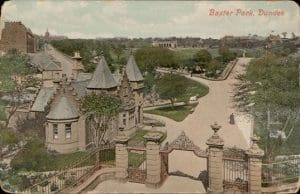
Although the Park was officially opened in 1863, the gates weren’t hung until 1865. But the gates hanging today aren’t the originals – they were removed as part of the scrap metal collection scheme during WW2. These ones are copies and were installed in the 1990s as part of the Park’s regeneration. The lodge was demolished in 1958. The Park Superintendent lived there, but the Park’s Trustees also used it for their committee meetings.
Answer: Games area
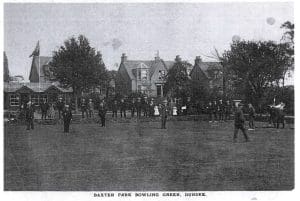
The first bowling green was built in the 1880s at the north of the Park and is still running. But after a deputation of ‘working men’ asked for other greens, three were built from the 1890s, now replaced by the new basketball court. The tennis court appeared just after WW1. You can also get fitter by trying out the new outdoor gym machines.
Answer: The Circle
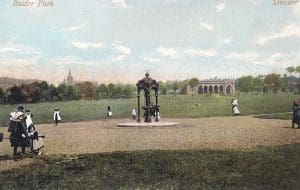 Apparently, Paxton had intended the circle to be laid out with flower beds, but David Baxter said no, and it was left empty, not even with seating. However, by 1922 it housed a fountain, one that had been relocated from the ‘Dell’ at the north of the Park. There had been at least three drinking fountains across the Park, all now disappeared as amenities and features have been added or changed over the years.
Apparently, Paxton had intended the circle to be laid out with flower beds, but David Baxter said no, and it was left empty, not even with seating. However, by 1922 it housed a fountain, one that had been relocated from the ‘Dell’ at the north of the Park. There had been at least three drinking fountains across the Park, all now disappeared as amenities and features have been added or changed over the years.
Answer: The recreation area
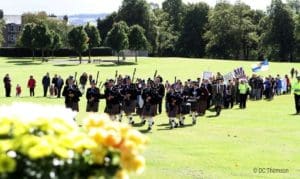
This part of the Park was planned for recreation. Paxton wanted flower beds dotted across the space, but David Baxter thought it better to leave it empty ‘in order that juveniles and others may have more room for exercise’. During WW2, part of the green was given over to allotments, so people could supplement their food rationing by growing vegetables
Answer: The Terrace
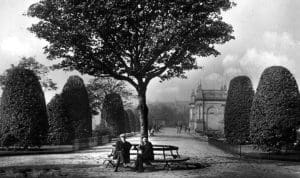
The Terrace was edged with conical holly trees soon after the Park opened, the bank was planted with shrubs, and stairs were built from the terrace down to the recreation area. McFarlane’s famous painting of the Park’s opening show eight statues along the terrace, but they were never there: maybe they proved too expensive. Instead, the holly trees were planted, and sycamores were planted within a circular seat in the gravel circles at either end. It’s likely that the sycamore still standing at the west end of the terrace was one of the original trees, making it the oldest tree in the Park.
Answer: The Pavilion
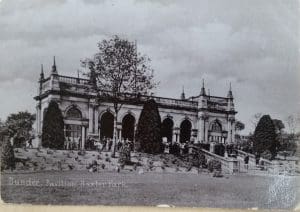
Now an A listed building, the Italianate Pavilion was designed by GH Stokes and is the Park’s centrepiece. Originally it was open to the outside, and housed a refreshment room, gardener’s room and a ‘ladies room’, with steps leading to a gallery on the roof, with views across the Tay to Fife. There was also a rather grand 6ft high fountain attached to the north wall, made of Sicilian marble and carved into the shape of a shell.
Answer: Sir David Baxter
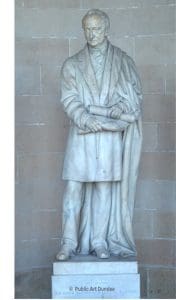
Over 18,000 Dundonians, who subscribed £1000 in just three weeks, paid for this statue of Sir David in 1863. But by 1894 it had to be removed as it had ‘been considerably injured by stone throwing’, a problem that had been happening for a while. The statue had been cleaned once before and ‘the marks of stone-throwing effaced’ but this was very expensive and, as the Park Keeper noted, short of having a ‘watchman constantly stationed at or near the pavilion’, the vandalism couldn’t be stopped.
Answer: The Bandstand
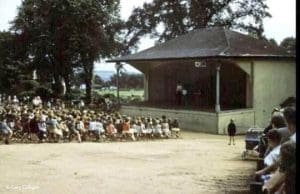
A bandstand was opened in 1925, built where the music could ‘be heard in almost every part of the northern portion of the Park’. Playing in the summer evenings and each Sunday, bands like the Royal Naval Volunteer Reserves and the Dundee Trades’ Band attracted huge audiences. The bandstand was also used to stage children’s talent shows, for concerts and dances and was used right up to the 1970s. The Activity Centre, built as part of the Park’s millennium regeneration, has replaced the bandstand.
Answer: Children’s playground
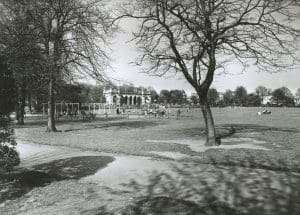
Baxter Park has had children’s playgrounds – or gymnasia as they were originally called – since the beginning of the 20th century. The first one, on the west of the recreation area, was laid with wooden flooring. It was extended in the 1930s and by the 1950s moved close to where the new playground sits today.
Answer: The Dell
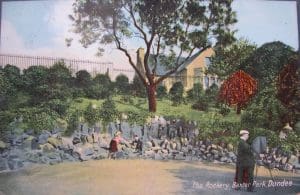
The ‘Knoll’ or ‘Dell’, was a key element of Paxton’s design for the Park. Part of an old quarry, the Dell became a rockery garden, planted with alpines and ferns. It proved so picturesque that on Saturday afternoons the paths were being blocked by photographers, and children climbed over the boulders and rocks, desperate to see what was a new invention. In the 1950s the Dell was infilled, and you may notice the old Elm sitting amongst some boulders, which is all that’s left.
Answer: The Flagpole
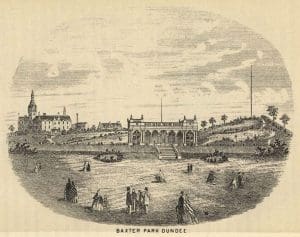
A flagpole was erected in 1868 right at the top of the Park. At 110 ft above the Arbroath Road, this platform was the last portion of the Park to be laid out in 1863. As the trees were young and small, the view could take in Broughty Castle in the east and Fife to the south. The view also looked west across to the Law, although when the mills were active, all that could be seen was ‘a curtain of smoke’ that hung across the towns.
